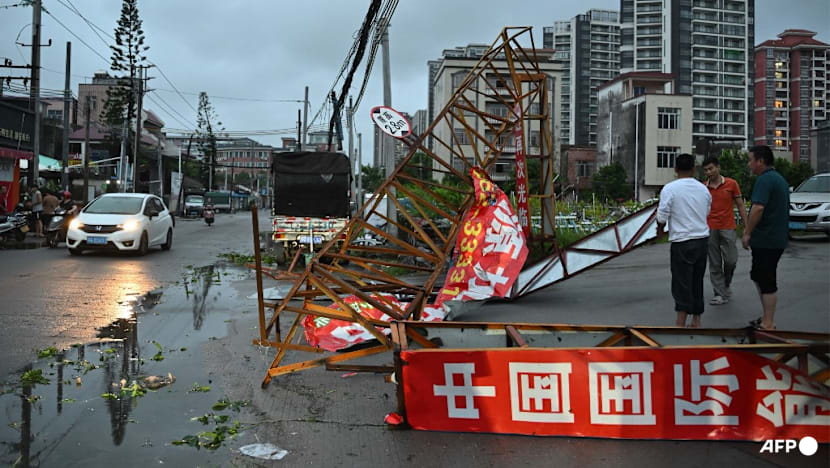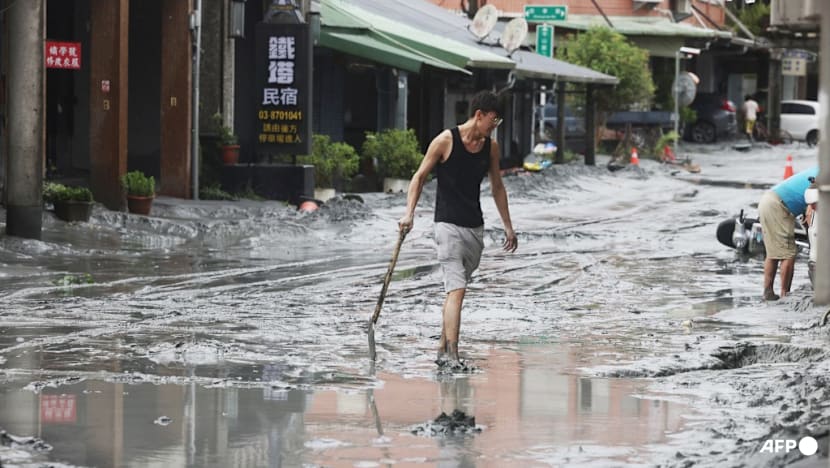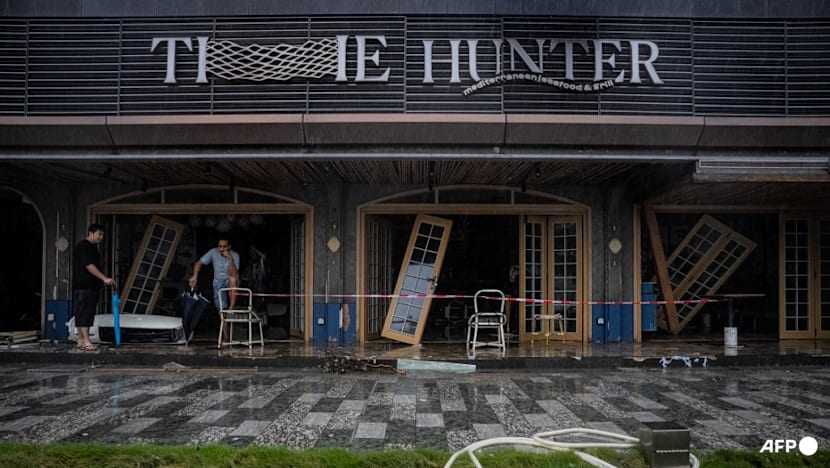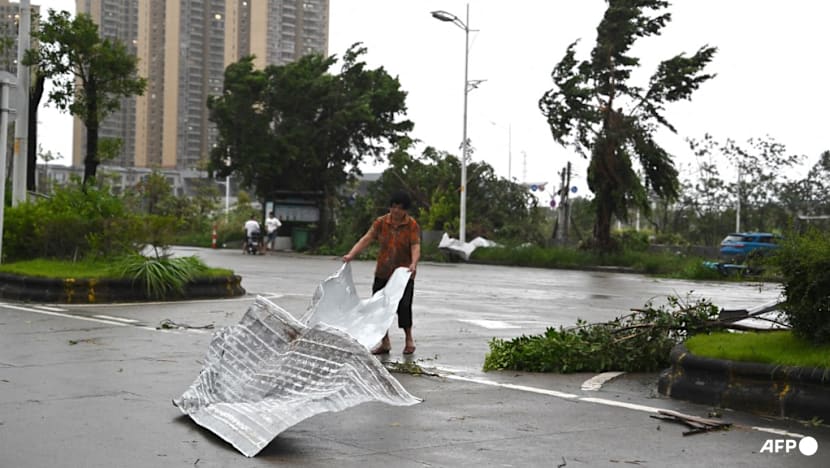Typhoon Ragasa bears down on southern China after killing 17 in Taiwan
More than 2 million people have been evacuated across Guangdong and the ministry for emergencies dispatched tens of thousands of tents, folding beds, lighting equipment and other rescue supplies.

People remove a fallen iron gate after the passing of Typhoon Ragasa in Yangjiang, southern China’s Guangdong province on Sep 24, 2025. (Photo: AFP/Adek Berry)
HONG KONG: Typhoon Ragasa, the world's most powerful tropical cyclone this year, struck the southern Chinese city of Yangjiang on Wednesday (Sep 24) after killing 17 people in Taiwan and lashing Hong Kong with ferocious winds and heavy rains.
The typhoon was tracking towards Maoming, one of China's biggest oil refining cities, in Guangdong province.
In Taiwan, 17 people were missing in the eastern Hualien county after a barrier lake overflowed and sent a wall of water into a town, while Ragasa brought Hong Kong to a standstill.
More powerful typhoons are likely to hit southern China due to climate change, said Benjamin Horton, dean of the School of Energy and Environment at the City University of Hong Kong, after a summer of record-breaking rainfall.
"The weather experienced in Hong Kong this summer is only a taste of what is to come," Horton said.

GUANGDONG GIVEN RED STORM SURGE WARNING
Officials in Taiwan are used to moving people out of potential danger zones swiftly, as the island is frequently hit by typhoons, but many residents in the tourist town of Guangfu said they were given insufficient warning when a lake overflowed during Tuesday's torrential rains brought by Ragasa.
In Hong Kong, where huge waves crashed over areas of the Asian financial hub's eastern and southern shoreline, some roads and residential properties were submerged.
At the Fullerton Hotel on the island's south, videos on social media showed seawater surging through glass doors. No injury has been reported, the hotel told Reuters.
China's marine authority issued its highest red wave warning for the first time this year, forecasting storm surges of up to 2.8m in parts of Guangdong province, as Ragasa headed towards the densely populated Pearl River Delta.

Ragasa formed over the Western Pacific last week. Fuelled by warm seas and favourable atmospheric conditions, the tropical cyclone rapidly intensified to become a Category 5 super typhoon on Monday with winds exceeding 260kph.
It has since weakened, but was still powerful enough to bring down trees and power lines.
"Authorities have taken lessons from Hato and Mangkhut, which both caused billions of dollars in damage in 2017 and 2018," said Chim Lee, a senior energy and climate change specialist at the Economist Intelligence Unit.
"The Pearl River Delta is one of the best-prepared regions for typhoons, so we're not expecting major disruptions. One change this year is that the Hong Kong stock market has stayed open during typhoons - a sign of how resilient the infrastructure has become," he said.
That said, Zijin Gold International delayed its US$3.2 billion IPO in Hong Kong on Wednesday.

MILLIONS OF PEOPLE IN STORM'S PATH
After passing around 100km south of Hong Kong, Ragasa made landfall along the south Chinese coast. Guangzhou, Shenzhen, Foshan and Dongguan, the largest cities in the storm's path, are home to around 50 million people.
More than 2 million people have been evacuated across Guangdong and the ministry for emergencies dispatched tens of thousands of tents, folding beds, lighting equipment and other rescue supplies, Chinese state media reported.
Some shops and restaurants in the province parked large rented trucks in front of storefronts in a bid to shield them from the storm, local media reported.
"We live on an upper floor and saw there wasn't too much danger, so I brought the kids out to experience this heavy rain and wind," a 40-year-old Shenzhen resident surnamed Liang said.
"We walked along the open road to make sure to stay safe."
A crowd chasing the storm under the Shenzhen Bay Bridge was moved on by the traffic police.
"The typhoon was really intense, but I've not been out long," said an electric scooter delivery driver who goes by the name of Tim and was using his vehicle to assess the damage.
China's marine authority warned of a high risk of flooding in Shenzhen, especially in low-lying areas, with a storm surge alert expected to remain in effect until Thursday.
A woman and her five-year-old son were swept into the ocean on Tuesday after watching the typhoon from the Hong Kong waterfront, according to the South China Morning Post, which said they were now in intensive care.
Hong Kong has lowered its typhoon signal to 3 from 8 since 8.20pm on Wednesday.
The hospital authority said at least 90 people had been injured by the typhoon, while the government had opened 50 temporary shelters, within which 885 sought refuge.
In the gambling hub of Macau, next to Hong Kong, casinos were forced to shutter their gambling areas. One user on China's Xiaohongshu app showed videos of doors being sealed at a casino resort for protection against gales and debris.














